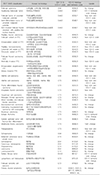Abstract
Thyroid tumors include a heterogeneous group of entities with variable clinical behavior and histology, mostly classified as benign or malignant. Neoplasm of uncertain or unknown behavior in thyroid gland was newly adopted by the 2017 edition of World Health Organization (WHO) classification of endocrine organs. The borderline thyroid tumors include a hyalinizing trabecular tumor and three encapsulated follicular-patterned thyroid tumors (follicular tumor of uncertain malignant potential, well-differentiated tumor of uncertain malignant potential, and non-invasive follicular thyroid neoplasm with papillary-like nuclear features). This review summarizes the changes in the 2017 WHO classification of thyroid tumors, highlights their implications for clinical practice in Korea, and briefly discusses National Health Insurance system, cancer insurance policies, and their associated benefits in Korea.
Figures and Tables
 | Fig. 1Schematic illustration of encapsulated follicular-patterned thyroid tumors on the basis of presence or absence of nuclear features of papillary thyroid carcinoma and capsular or vascular invasion by 2017 World Health Organization classification. EFVPTC: encapsulated follicular variant of papillary thyroid carcinoma, FT-UMP: follicular tumor of uncertain malignant potential, NIFTP: non-invasive follicular thyroid neoplasm with papillary-like nuclear features, WDC-NOS: well-differentiated carcinoma, not otherwise specified, WDT-UMP: well-differentiated tumor of uncertain malignant potential |
Table 1
Updates in nomenclature and classification of the 2017 World Health Organization (WHO) Classification of thyroid tumors

ICD-O: International Classification of Diseases for Oncology, ICD-10: the 10th revision of the International Statistical Classification of Diseases and Related Health Problems, FTC: follicular thyroid carcinoma, KCD-7: the 7th revision of Korean Standard Classification of Diseases, NOS: not otherwise specified, PTC: papillary thyroid carcinoma
References
1. Lloyd RV, Osamura RY, Klöppel G, Rosai J. WHO classification of tumours of endocrine organs. 4th ed. Lyon: IARC publication;2017.
2. Kakudo K, Bychkov A, Bai Y, Li Y, Liu Z, Jung CK. The new 4th edition World Health Organization classification for thyroid tumors, Asian perspectives. Pathol Int. 2018; 68(12):641–664.

3. Gowrishankar S, Pai SA, Carney JA. Hyalinizing trabecular carcinoma of the thyroid gland. Histopathology. 2008; 52(4):529–531.

4. Sambade C, Franssila K, Cameselle-Teijeiro J, Nesland J, Sobrinho-Simões M. Hyalinizing trabecular adenoma: A misnomer for a peculiar tumor of the thyroid gland. Endocr Pathol. 1991; 2(2):83–91.

5. Nikiforova MN, Nikitski AV, Panebianco F, Kaya C, Yip L, Williams M, et al. GLIS rearrangement is a genomic hallmark of hyalinizing trabecular tumor of the thyroid gland. Thyroid. 2019; 29(2):161–173.

6. Nikiforov YE, Seethala RR, Tallini G, Baloch ZW, Basolo F, Thompson LD, et al. Nomenclature revision for encapsulated follicular variant of papillary thyroid carcinoma: A paradigm shift to reduce overtreatment of indolent tumors. JAMA Oncol. 2016; 2(8):1023–1029.

7. Parente DN, Kluijfhout WP, Bongers PJ, Verzijl R, Devon KM, Rotstein LE, et al. Clinical safety of renaming encapsulated follicular variant of papillary thyroid carcinoma: Is NIFTP truly benign? World J Surg. 2018; 42(2):321–326.

8. Cho U, Mete O, Kim MH, Bae JS, Jung CK. Molecular correlates and rate of lymph node metastasis of non-invasive follicular thyroid neoplasm with papillary-like nuclear features and invasive follicular variant papillary thyroid carcinoma: the impact of rigid criteria to distinguish non-invasive follicular thyroid neoplasm with papillary-like nuclear features. Mod Pathol. 2017; 30(6):810–825.

9. Nikiforov YE, Baloch ZW, Hodak SP, Giordano TJ, Lloyd RV, Seethala RR, et al. Change in diagnostic criteria for noninvasive follicular thyroid neoplasm with papillarylike nuclear features. JAMA Oncol. 2018; 4(8):1125–1126.

10. Bychkov A, Jung CK, Liu Z, Kakudo K. Noninvasive follicular thyroid neoplasm with papillary-like nuclear features in Asian practice: Perspectives for surgical pathology and cytopathology. Endocr Pathol. 2018; 29(3):276–288.

11. Bychkov A, Keelawat S, Agarwal S, Jain D, Jung CK, Hong S, et al. Impact of non-invasive follicular thyroid neoplasm with papillary-like nuclear features on the Bethesda system for reporting thyroid cytopathology: a multi-institutional study in five Asian countries. Pathology. 2018; 50(4):411–417.





 PDF
PDF ePub
ePub Citation
Citation Print
Print




 XML Download
XML Download